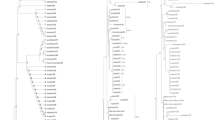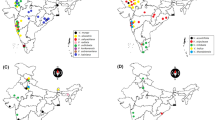Abstract
Sequence variation of nuclear internal transcribed spacer regions of ribosomal DNA (ITS1, 5.8S rRNA and ITS2) from Chinese vegetable mustards (AB-genome) and its putative parents Brassica rapa (the A-genome) and Brassica nigra (the B-genome) were used to investigate the molecular phylogeny and the probable evolutional pattern of this amphidiploid species that uniquely formed in China. Totally, 16 accessions of Chinese vegetable mustard those covering nearly all the diverse variations were included in this study, and together with three accessions of B. rapa and one accession of B. nigra. The results disclosed two strongly supported clades, one containing four accessions of vegetable mustard which have closer relationship with B-genome species “B.nigra” lineage and the other containing 12 accessions of B. juncea and three A-genome accessions. This classification was in disagreement with the evidence from chloroplast DNA, mitochondrial DNA, nuclear DNA restriction fragment length polymorphism (RFLP), which suggested that B. juncea was closely related to the A-genome type. For the incongruence, we speculated that the B. juncea crops derived from Chinese have evolved through different recombined events of the diploid morphutypes and evolved unidirectional concerted evolution. The traditional phenotypic classification of B. juncea was not wholly supported by ITS results, and hence the phylogenetic relationships among these subspecies need to be reconsidered on molecular level.





Similar content being viewed by others
Refenences
Ainouche ML, Bayer R (1997) On the origins of the tetraploid Bromus species (section Bromus, Poaceae): in-sights from internal transcribed spacer sequences of nuclear ribosomal DNA. Genome 40:730–743
Baldwin BG, Sanderson MJ, Porter JM, Wojciechowski MF, Campbell CS, Donoghue MJ (1995) The ITS region of nuclear ribosomal DNA: a valuable source of evidence on angiosperm phylogeny. Ann Mo Bot Gard 82:247–277
Buckler ES, Holtsford TP (1996) Zea systematics: ribosomal ITS evidence. Mol Biol Evol 13:612–622
Chen C-L, Chen X-Q (1992) A study on origin of Brassica juncea Coss. in China. J Southwest Agric 5:6–11 (in Chinese)
Downie SR, Katz-Downie D (1996) A molecular phylogeny of Apiaceae subfamily Apiaceae: evidence from nuclear ribosomal DNA internal transcribed spacer sequences. Am J Bot 83:234–251
Doyle JJ, Doyle JL (1990) Isolation of plant DNA from fresh tissue. Focus 12:13–15
Erickson LR, Straus NA, Beversdorf WD (1983) Restriction patterns reveal origins of chloroplast genomes in Brassica amphidiploids. Theor Appl Genet 65:201–206
Fu J, Zhang MF, Qi XH (2005) Genetic diversity of traditional Chinese mustard crops as revealed by phenotypic differences and RAPD markers. Genet Resour Crop Evol 53:1513–1519
Gladis T, Hammer K (1992) The Brassica collection in Gatersleben: Brassica juncea, Brassica napus, Brassica nigra, and Brassica rapa. Feddes Rep 103(7–8):469–507
Koch MA, Dobe C, Olds TM (2003) Multiple hybrid formation in natural populations: concerted evolution of the internal transcribed spacer of nuclear ribosomal DNA (ITS) in Northern American Arabis divaricarpa (Brassicaceae). Mol Biol Evol 20:338–350
Koch MA, Al-Shehbaz I (2000) Molecular systematics of the Chinese Yinshania (Brassicaeae): evidence from plastid trnL intron and nuclear ITS DNA sequence data. Ann Missouri Bot Gard 87:246–272
Lionneton E, Aubert G, Ochatt S, Merah O (2004) Genetic analysis of agronomic and quality traits in mustard (Brassica juncea). Theor Appl Genet 109:792–799
Liu P-Y (1996) Chinese Mustard. China Agriculture Press, Beijing, pp 46–56 (in Chinese)
Mukherijea P (1975) Karymorphological studies of ten strains of India mustard (Brassica juncea Coss). Euphytica 24:483–486
Oram RN, Kirk JTO, Veness PE, Hurlstone CJ, Edlington JP, Halsall DM (2005) Breeding Indian mustard [Brassica juncea (L.) Czern.] for cold-pressed, edible oil production – a review. Aust J Agricult Res 56:581–596
Palmer JD, Herbon LA (1988) Plant mitochondrial DNA evolves rapidly in structure, but slowly in sequence. J Mol Evol 28:87–97
Palmer JD, Shields CR, Cohen DB, Orton TJ (1983) Chloroplast DNA evolution and the origin of amphidiploid Brassica species. Theor Appl Genet 65:181–189
Prakash S, Hinata K (1980) Taxonomy, cytogenetics and origin of crop Brassica. A review. Opera Bot 55:1–57
Song KM, Osborn TC, Williams PH (1988) Brassica taxonomy based on nuclear restriction fragment length polymorphisms (RFLPs) 1. Genome evolution of diploid and amphidiploid species. Theor Appl Genet 75:784–794
Song KM, Osborn TC, Williams PH (1990) Brassica taxonomy based on nuclear restriction fragment length polymorphisms (RFLPs) 3. Genome relationships in Brassica and related genera and the origin of B. oleracea and B. rapa (syn. campestris). Theor Appl Genet 76:497–506
Swofford DL (1998) PAUP* Phylogenetic analysis using parsimony (*and other methods) (version 4). Sinauer Associates, Sunderland, Massachusetts, USA
Thompson JD, Gibson TJ, Plewniak F, Jeanmougin F, Higgins DG (1997) The Clustal X windows interface: flexible strategies for multiple sequence alignment aided by quality analysis tools. Nucleic Acids Res 24:4876–4882
U N (1935) Genome analysis in Brassica with special reference to the experimental formation of B. napus and peculiar mode of fertilization. Jpn J Bot 7:389–452
Warwick SI, Black LD (1991) Molecular systematics of Brassica and allied genera (subtribe Brassicinae, Brassiceae) - chloroplast genome and cytodeme congruence. Theor Appl Genet 82:81–92
Wendel JF, Schnabel A, Seelanan T (1995a) An unusal ribosomal DNA sequence from Gossypium gossypioides reveals ancient, cryptic, intergenomic introgression. Mol Phylogenet Evol 4:298–313
Wendel JF, Schnabel A, Seelanan T (1995b) Bidirectional interlocus concerted evolution following allopolyploid speciation in cotton (Gossypium). Proc Natl Acad Sci 92:280–284
White TJ, Bruns T, Lee S, Taylor J (1990) Amplification and direct sequencing of fungal ribosomal RNA genes for phylogenetics. In: Innis M, Gelfand D, Sninsky JJ, White TJ (eds) PCR protocols: a guide to methods and applications. Academic Press, San Diego, Calif, pp 315–322
Yang YW, Lai KN, Tai PY, Ma DP, Li WH (1999) Molecular phylogenetic studies of Brassica, Rorippa Arabidopsis, and allied genera based on the internal transcribed spacer region of 18S–25S rDNA. Mol Phylogenet Evol 13:455–462
Yang YW, Tai PY, Chen Y, Li WH (2002) A study of the phylogeny of B.rapa, B.nigra, Raphanus sativus, and their related genera using noncoding regions of chloroplast DNA. Mol Phylogenet Evol 13:455–462
Yuan YM, Kupfer P, Doyle JJ (1996) Infrageneric phylogeny of the genus Gentiana inferred from nucleotide sequences of internal transcribed spacers of the nuclear ribosomal DNA. Am J Bot 83:641–652
Acknowledgements
We are thankful to the Institute of Vegetable and Flower, Academy of Agricultural Sciences of China for providing us some accessions in this investigation. We are also grateful to Dr Chen Shi-chao and Zheng Xiao-yan for their generosity in offering the analysis software and valuable advice.
Author information
Authors and Affiliations
Corresponding author
Rights and permissions
About this article
Cite this article
Qi, XH., Zhang, MF. & Yang, JH. Molecular phylogeny of Chinese vegetable mustard (Brassica juncea) based on the internal transcribed spacers (ITS) of nuclear ribosomal DNA. Genet Resour Crop Evol 54, 1709–1716 (2007). https://doi.org/10.1007/s10722-006-9179-0
Received:
Accepted:
Published:
Issue Date:
DOI: https://doi.org/10.1007/s10722-006-9179-0




